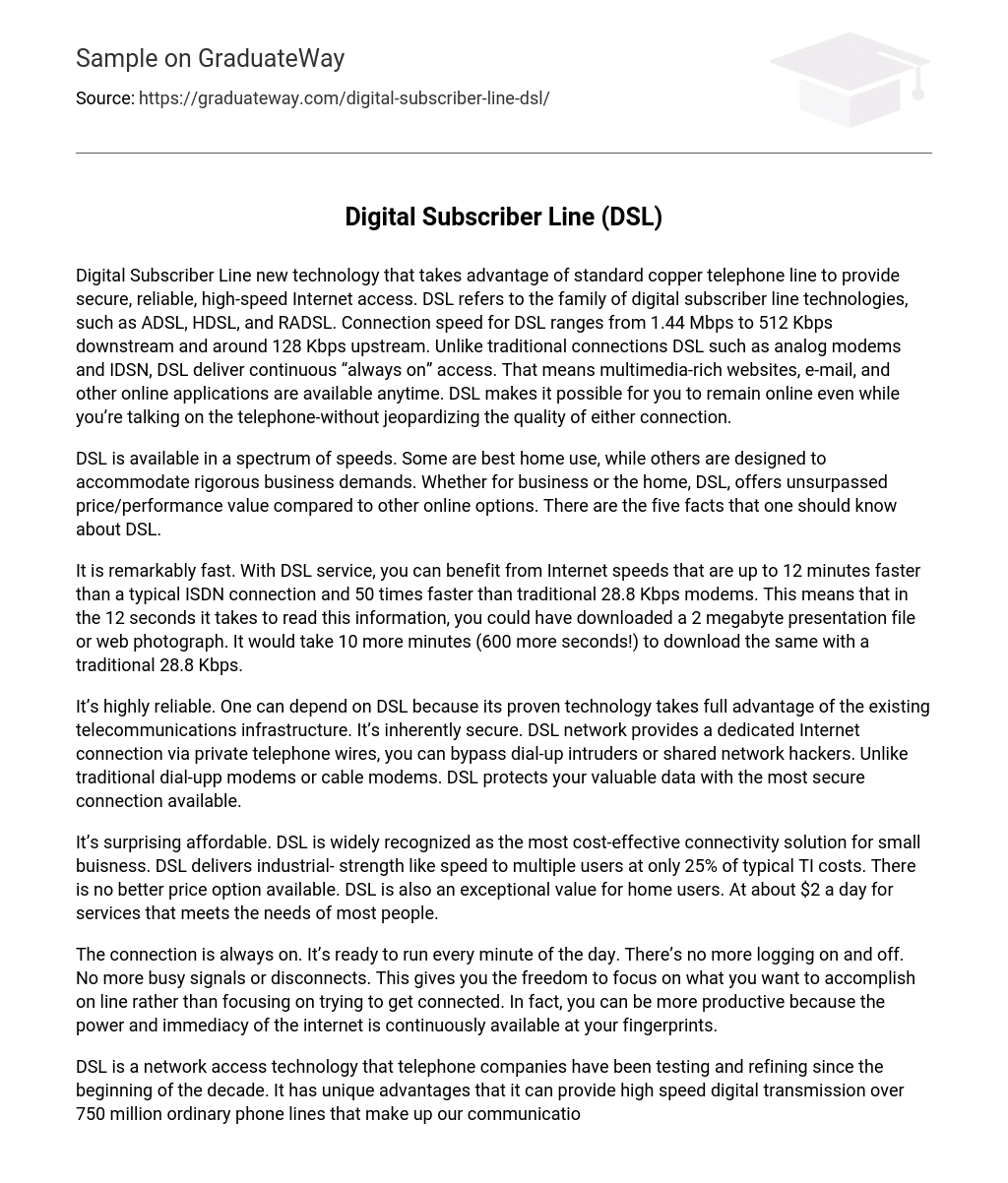DSL, also known as Digital Subscriber Line, is a modern technology that makes use of regular copper telephone lines to provide secure and dependable high-speed internet access. It includes different types of digital subscriber line technologies like ADSL, HDSL, and RADSL. DSL provides connection speeds ranging from 1.44 Mbps to 512 Kbps downstream and approximately 128 Kbps upstream. Unlike traditional connections like analog modems and IDSN, DSL ensures uninterrupted “always on” access. This means you can access multimedia-rich websites, email, and other online applications whenever you want. With DSL, you can remain connected even while using the telephone without compromising either connection’s quality.
DSL comes in various speeds, catering to both home and business needs, delivering unmatched price/performance value in comparison to other online options. Here are five essential facts about DSL.
DSL service offers significantly faster internet speeds compared to ISDN and traditional 28.8 Kbps modems. In fact, DSL can be up to 12 times faster than ISDN and 50 times faster than 28.8 Kbps modems. To put this into perspective, while it takes 12 seconds to read this information, you could have already downloaded a 2 megabyte presentation file or web photograph. On the other hand, it would take an additional 10 minutes (or 600 more seconds) to download the same file using a traditional 28.8 Kbps modem.
DSL is a highly reliable and secure technology that utilizes the existing telecommunications infrastructure. It offers a dedicated Internet connection through private telephone wires, eliminating the risk of dial-up intruders or network hackers. Compared to traditional dial-up modems or cable modems, DSL provides the most secure connection to protect your valuable data.
DSL is recognized for its affordability, making it the most cost-effective connectivity solution for small businesses. It provides high speeds suitable for multiple users at a fraction of the usual TI costs, making it an excellent value option. Moreover, it is also a great choice for home users as it only costs around $2 per day to meet their needs.
With the internet, you can stay connected at all times without the inconvenience of logging on and off or dealing with busy signals and disconnects. This constant connectivity enables you to focus on your online tasks and be more productive, as the power and immediacy of the internet are always accessible.
DSL, also known as Digital Subscriber Line, is a network access technology that has been tested and improved by telephone companies since the beginning of the decade. DSL offers a notable benefit: it can provide high-speed digital transmission over the extensive network of 750 million ordinary phone lines that make up our communication infrastructure.
Speed: 384 Kbps, 128 Kbps, 28.8 Kbps
2 Mb image files
72 seconds
3.6 minutes
15.9 minutes
72 MB video
43 minutes
2.2 hours
9.6 hours
DSL technology offers users uninterrupted access to the Internet or corporate LANs at speeds that are significantly faster than traditional 56.6 kilobits per second modems, ranging from 25 times to 100 times faster. The utilization of advanced digital coding techniques by DSL modems allows for the optimization of regular phone lines, resulting in super-fast network access speeds.
Originally, DSl was created with the intention to facilitate video on demand services for telephone companies as a means to compete with cable companies. However, many companies have since shifted their focus away from offering such services. Instead, the high speed capacity of DSL has made it the preferred technology for large corporations leasing lines for private voice and data networks.
There are various types of DSL available:
ASDL is a service that allows for faster transmission in one direction (1.544 Mbps downstream to the house) compared to the other direction (384 Kbps to the telephone company’s CO). It caters to high power internet users who desire quicker downloads of large files and resources from the web.
The Symmetric Digital Subscriber Line (also known as the single line) offers 144 Kbps of bandwidth in both directions. SDSL is more affordable compared to other DSL services. It has the capability to transmit data in both directions and is well-suited for various business applications, such as internet access or connecting remote offices of large corporations.
ISDN Digital Subscriber line service is a business-oriented service designed to accommodate users who have already invested in ISDN. This service provides ISDN signalling at 144 Kbps over a DSL circuit and can be plugged into existing ISDN equipment at a local carrier’s CO.
High speed Digital Subscriber Line, running at around 6 Mbps, is utilized to provide T-1 digital services (1.544 Mbps) over standard telephone lines.





